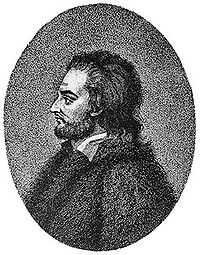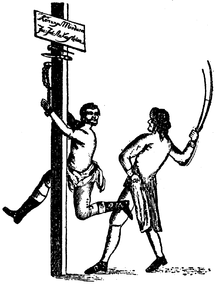Jacob Johan Anckarström
| Jacob Johan Anckarström | |
|---|---|
 | |
| Born | 11 May 1762 |
| Died |
27 April 1792 (aged 29) Stockholm, Sweden |
| Occupation | Military captain |
Criminal penalty | Death |
| Criminal status | Executed |
| Conviction(s) | Murder |
Jacob Johan Anckarström (11 May 1762 – 27 April 1792) was a Swedish military officer who was convicted and executed for regicide. He was the son of Jacob Johan Anckarström the Elder. He served as a captain in King Gustav III's regiment between 1778 and 1783. During travels to Gotland, he was accused of slandering the king and fled to Stockholm, where he spent the winter, but was subsequently arrested, brought back and tried in Gotland. Although he was acquitted due to lack of evidence, he later maintained in his confession that this incident sparked his fire of hatred towards the king, fuelled by the contemporary revolutionary movement in Europe.

On 16 March 1792, Gustav III had returned to Stockholm, after spending the day at Haga Palace outside the city, to dine and visit a masquerade ball at the Royal Opera. During dinner, he received an anonymous letter that contained a threat to his life, but as the king had received numerous threatening letters in the past, he chose to ignore the warning.
After dining, he left his rooms to take part in the masquerade. Soon after entering, he was surrounded by Anckarström and his co-conspirators, among them Counts Claes Horn and Adolf Ribbing, who wore black masks and greeted him in French with the words "Bonjour, beau masque" ("Good-day, fine mask"). Anckarström moved in behind the king and fired a pistol-shot into the left side of his back. The murder weapon was loaded with two balls, five shot and six bent nails. The King jumped aside, crying in French "Ah! Je suis blessé, tirez-moi d'ici et arrêtez-le" ("Ah! I am wounded, take me away from here and stop him!"). The king was immediately carried back to his quarters, and the exits of the Opera were sealed. Anckarström was able to flee before the doors were sealed, but left the pistols behind, which were brought around to several gun-smiths the next morning. A gun-smith, who had repaired them for Anckarström, recognised them and identified him as their owner. Anckarström was arrested the same morning and immediately confessed to the murder, although he denied a conspiracy until he was informed that Horn and Ribbing had been arrested and confessed in full.
Anckarström was jailed in a prison not far from the Royal Palace in Stockholm. Today the former prison is an underground restaurant named after the viceroy Sten Sture.
Curiously, the murder had been predicted to the king four years earlier, when he paid an anonymous visit to the celebrated medium of the Gustavian era, Ulrica Arfvidsson.[1] She was often employed by his brother, Duke Charles, and was said to have a large net of informers all over town; she was never suspected to be involved, but she was questioned about the murder. In 1791, Charlotta Roos also predicted misfortune to King Gustav III, something he reportedly referred to on his death bed after the assassination.[2]
Gustav III died of his wounds on 29 March, and on 16 April Anckarström was sentenced. He was stripped of his estates and nobility privileges. He was sentenced to be cast in irons for three days and flogged, and his right hand was to be cut off before he was decapitated. The execution took place on 27 April 1792.
In the same year, the Anckarström family changed its surname to Löwenström and donated funds for a hospital as a gift of appeasement. This resulted in the Löwenström Hospital, or Löwenströmska sjukhuset. Living descendants of Anckarström include Ulf Adelsohn and the American actress Alexandra Neil.
Operas
Anckarström is a character in Daniel Auber's opera Gustave III and Giuseppe Verdi's Un ballo in maschera (A Masked Ball). In the operas, his motivation is changed to jealousy over his wife Amelia, with whom Gustav is portrayed as being in love. He is actually portrayed as being Gustav's close friend before he switches allegiances. Gustav pardons him with his last breath. In the censored version of the Verdi libretto, set in Colonial-era Boston, he is called Renato (Rene).[3][4]
References
- ↑ Carl Forsstrand (1913). Spåkvinnor och trollkarlar. Minne och anteckningar från Gustav III:s Stockholm (Andra upplagan). [Fortune tellers and magicians. Memory and notes from the Stockholm of Gustav III] Stockholm: Hugo Gebers Förlag. ISBN
- ↑ Carl Forsstrand (1913). Spåkvinnor och trollkarlar. Minne och anteckningar från Gustav III:s Stockholm (Andra upplagan). [Fortune tellers and magicians. Memory and notes from the Stockholm of Gustav III] Stockholm: Hugo Gebers Förlag. ISBN p. 35-36
- ↑ Fisher, Burton D. (2004). A Masked Ball: (un Ballo in Maschera). Opera Journeys. p. 23. ISBN 0-9761035-3-2.
- ↑ Gerhard, Anselm (2000). The Urbanization of Opera: Music Theater in Paris in the Nineteenth Century. Mary Whittall. University of Chicago Press. p. 409. ISBN 0-226-28858-7.
|